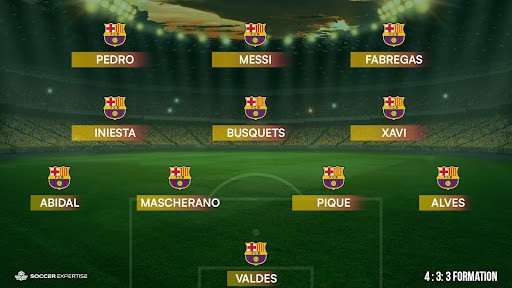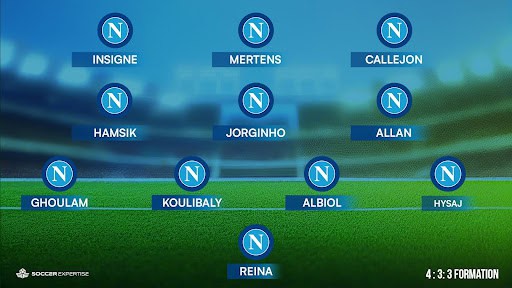The 4-3-3 formation is popular in modern soccer thanks to the achievements of the Barcelona team between 2008 and 2012. Spanish coach Pep Guardiola led the team to its victories at that time.
While Pep was not the first to use this formation, how he executed it made a lot of managers attempt to replicate his successes. Now, when new soccer fans tune into a game, they are more likely to see the outfield players laid out in a 4-3-3 or any of its variations.
What makes it so successful? Why is everybody using it? Most importantly, how did it come about?
Stick around and find out.
What is a 4-3-3 Formation?
The 4-3-3 formation is a soccer layout that uses four defenders (two center-backs and two fullbacks), three midfielders, and three attackers (one center-forward/striker and two wingers).
The formation is primarily an attacking one. Coaches and team managers who employ this often do so at the expense of a solid defense. They are mostly subscribers to the school of thought that believes that attack in soccer is the best form of defense.
There are several variations of the 4-3-3 formation. The most common one has a defensive midfielder in front of the center-backs.
The DM is positioned just behind two center-midfielders. These CMs primarily assist in attack but must operate laterally to assist in the defense.
Other variations of the 4-3-3 include:
- Two DMs with one attacking midfielder (AM)
- Four midfielders (DMs, CMs, and an AM) with two center-forwards. It is also called the 4-3-1-2 formation.
- Five midfielders (DMs, CMs, and AMs) and one center-forward. Also called the 4-5-1 or 4-3-2-1 formation.
Coaches create these variations by just adjusting the positions of the players and throwing in an extra midfielder in the place of a striker to suit whatever tactics they come up with for the game.
The 4-3-3 formation was first popularized by the 1962 FIFA World Cup-winning Brazil national soccer team. Teams had begun to catch up to their 4-2-4 tactic and adapted it to 4-4-2, so they dropped one of the attackers into the midfield to create the 4-3-3.
Rinus Michels then introduced a new dimension to the 4-3-3 as the Netherlands and then AFC Ajax coach in the 1970s. His deployment of the formation led to many variations of the formation and the birth of the “Total Football” concept.
What is 4-3-3 formation good for?
Pay close attention to a team that is set up with the 4-3-3 formation. You will notice that there are naturally occurring triangles on the pitch.
In defense, the right fullback, the right center-back, and the defensive midfielder are one triangle. The same triangle occurs on the left with the DM at the tip. The three midfielders are also a triangle. The two center-midfielders and the striker are a triangle.
The reason for these triangles is ball possession and progression. Players have a man close by with whom they can exchange passes to progress the ball towards their opponent’s goal to score.
The formation is one of the best for attack in soccer. Teams playing in the 4-3-3 shape usually end up with five attackers because the central midfielders join the center-forward in the middle as the wingers go wider.
The fullbacks can progress very high up the pitch to join the attack while the wingers invert to support the striker. In this case, the midfielders remain in their zone to stifle counter-attacks.
These triangles also help in defense. Teams who attempt to attack from the middle can be cornered in the midfield by the midfield triangle.
If they take it to the wings, the defensive triangles that the DM will set up with the fullbacks and center-backs are there to stifle the opponent’s attack.
What is the Weakness of a 4-3-3?
Just as the triangles in a 4-3-3 help in defense, they also expose the team to danger.
The fullbacks are usually very advanced, as it is a primarily attacking soccer layout. This leaves the 4-3-3 defensive shape in the hands of midfielders who are not defense specialists.
The defensive midfielder can also be isolated in 4-3-3 formation tactics. If counterattacks happen while the center-midfielders are high up the pitch to support the attack, the DM will be the only one left to deal with the onslaught of opposing players.
This allows opponents to switch play at the drop of the hat to a space that will most likely have been caused by the scramble to regain their defensive shape.
Only players with considerable stamina and soccer intelligence can exploit the 4-3-3 formation strength.
Strikers in the 4-3-3 formation can sometimes find themselves isolated. When the wingers are being closed down by the opponent’s fullbacks, or when the wingers are not having their best game, the strikers are left without service.
This can force the striker to drop deep, which halves the attacking power of the 4-3-3 formation tactics.
Players’ in-possession Responsibilities in a 4-3-3
Each player in a 4-3-3 has a responsibility when their team is in possession, which I will outline here.
Defenders
The 4-3-3 defensive shape is not much different from a 4-4-2: the fullbacks prevent the opposing wingers from making any impact, while the center-backs work to stop the strikers and runners from the midfield from having any shots at goal.
However, the 4-3-3 formation tactics require the fullbacks to progress higher up the pitch to either join the attack or provide cover for the midfielders who join the attack.
Midfielders
Some coaches deploy two attacking midfielders and one central midfielder instead of a defensive midfielder and two central midfielders.
When coaches use attacking midfielders, their idea is to fully bank on the 4-3-3 formation strength in attack.
The central midfielder serves as the deep-lying playmaker in this variation, starting the plays and allowing the attacking midfielders to push the attack.
In the regular deployment with a defensive midfielder, one center-midfielder acts as the deep-lying playmaker while the other one acts as an attacking midfielder.
Attackers
Wingers work to isolate fullbacks in the 4-3-3 formation. This creates space for the center-midfielders to exploit with their passes or their runs.
When the winger is inverted and runs into the penalty area, there is space for the overlapping fullback to exploit down the wing for an extra man in attack.
The center-forward is there to provide support in attack by pinning one or both centerbacks to create space for themselves or their partners in attack.
Players’ Out-of-possession Responsibilities in a 4-3-3
The 4-3-3 defensive shape is more porous than those of other soccer layouts. However, if a coach deploys the formation, this means he wants the defense to start from the front.
The attackers will be the first line of pressure, forcing the ball wide and blocking middle passing or ball-carrying lanes from the defense.
The three midfielders can quickly adapt to become three defensive midfielders in this case, forming triangles with whoever is available to stifle attacks.
They can also align with the wingers to form a 4-1-4-1 defensive shape, where they cover the middle areas as the wingers force the attack to go wide.
The back four will remain as compact as possible, defending as a unit on either flank while the wingers drop back to create the illusion of five defenders. This is called sliding because the defenders move from side to side like on a Fussball table.
Is the 4-3-3 Lineup the Best in Soccer?
Looking at some of the successes, you would be inclined to believe that the 4-3-3 is the best soccer layout.
- The success that Mario Zagallo’s Brazil team of the late 1960s and early 1970s achieved with it.
- The impressive performance of Rinus Michels’ teams of the 1970s.
- Johan Cruijff revolutionized the formation to birth the Total Football concept.
- The formation made Lionel Messi one of the greatest footballers in the world.
However, it is just one of many strategies that can help a coach win a game. What matters is the smart application of it.
Which Are the Best Examples of Teams Using a 4-3-3?
Three teams come to mind when one thinks about the best use of the 4-3-3 in modern football: Pep Guardiola’s Barcelona, Jürgen Klopp’s Liverpool, and Maurizio Sarri’s Napoli.
These coaches applied the 4-3-3 formation tactics in different ways to great effect. Let us take a closer look at how they did it.
Pep Guardiola’s Barcelona

The 4-3-3 is Barcelona’s legacy, thanks to Total Football’s main propagator, Johan Cruijff. Guardiola used both wide and inverted wingers in his style, depending on which players he had at the time. This allowed his midfielders to distribute the ball easily.
He also deployed the False 9 system in his 4-3-3, which deceived the opposing center-backs. Again, his players made the difference with their technical ability, but his methods worked; otherwise, the players he had would have struggled.
Jürgen Klopp’s Liverpool

This was so effective, that the mere sight of Sadio Mane and Mohamed Salah caused defenses to tremble. Roberto Firmino, who was the center-forward, was a false 9 which allowed either winger to invert well enough to trouble the defense of their opponents.
His fullbacks Trent Alexander-Arnold and Andy Robertson would overlap to send crosses into the penalty area when Mane and Salah were unable to find space with their inverted runs.
Maurizio Sarri’s Napoli

Maurizio Sarri has tried and failed to replicate the brand of 4-3-3 he played while he was Napoli’s coach.
He used a deep-lying playmaker in Jorginho who was supported by two midfielders (one a center mid and the other an attacking mid). They were the heart of his 4-3-3.
The overlapping runs of his fullbacks and the inversion of the wingers allowed his attacking midfielder (Marek Hamsik) to move to either wing or run into central positions.
In defense, Alan, his center midfielder, would join Jorginho to provide defensive cover. The Italian midfielder would then start the attack by releasing Alan, who would then find the attackers of Hamsik.
Everybody wanted Sarri to coach their team because of his unique take on the 4-3-3.
Final Thoughts
Soccer is a low-scoring sport, so many managers deploy the 4-3-3 layout to enhance their team’s chances of scoring. It remains the best-attacking formation and has just enough balance to help in the defense.
The triangles it firms on the pitch look pretty cool, which adds some level of aesthetics to the game. For this reason, it will take a while before the variations of the 4-3-3 formation tactics become out of fashion.

